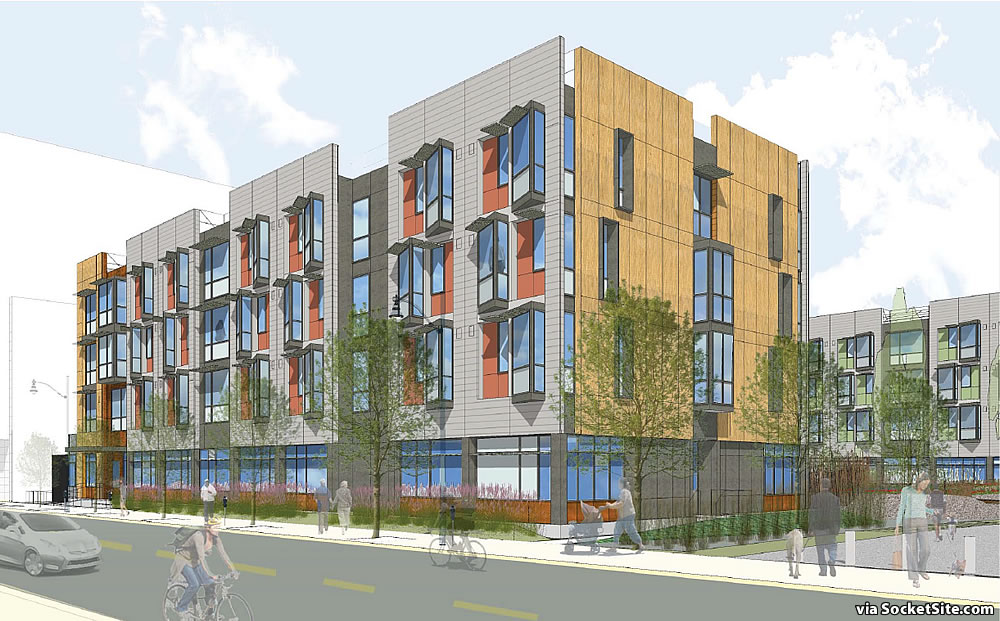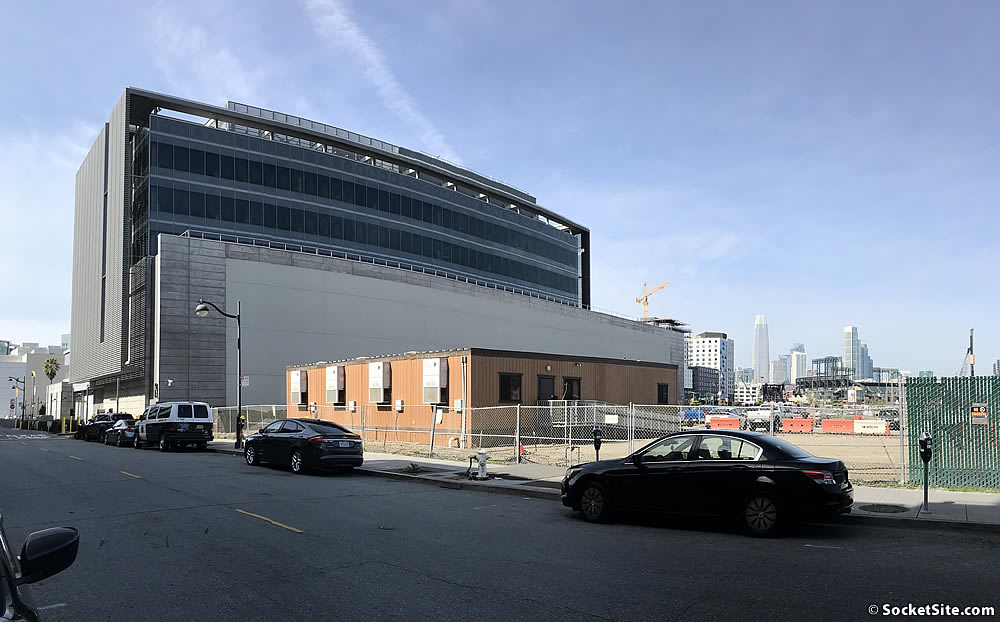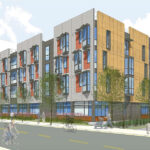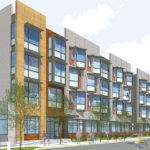As we outlined earlier this year:
The ground for the 141-unit modular development to rise on Mission Bay South Block 9, adjacent to San Francisco’s new Public Safety Building and across the street from Phase 2 of the Giants’ massive Mission Rock development, is tentatively slated to be broken this June.
If everything goes as planned, the four-story development will take around 17 months to complete (versus closer to 24 months if fully built on-site) and should be ready for occupancy by the end of next year.
The development will be managed by BRIDGE Housing and Community Housing Partnership.
And once again, the 141 studio units, which will average around 400 square feet apiece and had been projected to cost around $427,000 per unit to develop, including common areas but not accounting for the value of the underlying (publicly-owned) land, will be made available to currently homeless and extremely low-income households earning less than 30 percent of the area median income, the individual threshold for which is currently $25,850 per year or $29,550 for a couple.
While the ground floor of the building will be constructed on-site, the upper floor modules will be constructed by Factory OS on Mare Island in Vallejo and trucked to the Block 9 site for final assembly, as newly rendered below.
And the total budget for the 141-unit development, which now includes $13.6 million in soft costs and a $3.11 million developer fee, but still doesn’t account for the value of the underlying, publicly-owned land (which is being leased for a buck), is up to $81,359,601 or roughly $577,000 per unit and $812 per square foot.




I’m liking the contemporary interpretation of bay windows!
Would it actually cost *more* than $812/sqft to build if non-modular construction technology was being use?
with lands costs, these “cheaper” modular units are still ~$1000/sq ft. insane
So-called “affordable” housing is some of the most expensive housing to create — as everyone needs to get their “slice-of-the-pie”, the unions, the politicians, the “non-profit” developers, whose developer fee is double of what is standard in the “marketrate” sector.
This project is even more expensive per square foot then the notorious Sunnydale re-build reported on last year.
“Luxury” housing — for the lucky few –,brought to you courtesy of the taxpayers.
I think that’s a reasonable question to ask. The statewide average for a new affordable unit under the Low-Income Housing Tax Credit (LIHTC) program (not saying that’s the same program the above project used) is $700 per ft² as of 2019. The majority of those units are not modular construction.
Maybe the selling point is that modular construction isn’t as susceptible to the quality shortcuts that on-site stick construction contractors like to pull all the time in multi-family projects.
That statewide average includes land cost, yes?
To do it in SF with union labor? Yes.
excited for modular potential…but we really can’t get one or two more floors on there?!
Agreed, if we go modular can we make it expandable? add more on top as we need?
Agreed. I think this is a case where, especially given the taller context of much of the area, the case for going higher is pretty inarguable.
I’m curious, how do the management (Bridge and Community Housing Partnership) go about recruiting tenants? Is there a lottery like other BMR units? Do they stop by the local encampments and sign people up?
Would tenants ever move out of units like this? I certainly wouldn’t if I were making 30% of the AMI…
This project is reserved for the currently homeless — so if you don’t fall into this category, you’re outta luck.
Two questions –
1. How did cost get to $800 per sq ft without land cost?
2. How does a person making $25K afford a $570K mortgage?
But GLAD to see project like this which, hopefully, proves to the CITY it is not that smart at all…..
The units will be rentals and residents will pay 30 percent of their monthly income toward rent, with a target income of up to 30 percent of the Area Median Income (AMI) for new residents and a maximum allowable income of up to 60 percent of the AMI (which would equate to a maximum rent of $1,293 per month based on the current AMI), allowing for both stability and upward mobility at the same time.
IC. thanks for clarifying…
Well, then I wish City build more of these
Prevailing wage labor
Impact fees
Fixed percentage development fee – more expensive, bigger fee
Not sure about the funding (probably tax-credit?) but not traditional profit-driven incentives
The map (showing the intersection of 4th Street and MB Blvd South) is wrong by several blocks for the location of the proposed building.
$577k per unit is pretty good, especially given today’s LA Times story about a waylaid affordable project that would cost $1.1 million per unit. Granted the unit sizes are totally different, but I’ll take our victories on cost when we get them.
Parcel 9 is 1.08 acres next to waterfront, a premium piece of land. Any commercial RE out there? Curious to what is the appraisal value of the land if placed on the market for sale to private developers like the Warriors, a bio tech, condo builder, hotel builder? $50 million?
Houses can be bought on Ohio for $50 a sq. ft. But we have to spend $800 a sq. ft to value signal for a very exclusive few lottery winners in San Francisco. “Progressive” politics are truly the road to hell paved with allegedly “good” intentions.
This is an intentionally and absurdly gross oversimplification. Intellectual dishonestly is bad, mkay.
Anonymous is practicing “ad hominem” attacks by primarily denigrating the motives of Clyde Benke, instead of his argument. Therefore, Anonymous displays cowardice (in the name choice), as well as the very qualities purported to exist in another.
Spot on.
It is probably a better use of money to sell the land to the highest bidder, and then donate the development funds to fund homeless people moving to a different area–with a lower cost of living (and where more could be assisted and are more likely to be gainfully employed). This would assist in breaking the cycle of systemic poverty in an increasingly service and technology-based economy that will continue to gentrify and become more expensive.
However, the vested interests of the local homeless-development complex would lose their own employment and/or societal virtue signaling in this scenario. Therefore, it will never happen.
This isn’t housing targeted at the recently homeless. You’ve invented a counter-factual thing to argue against.
Yes it is
“will be made available to currently homeless and extremely low-income households”
Regarding the question about how management (Bridge and Community Housing Partnership) go about recruiting tenants, this is done through the Mayor’s Office of Housing and Community Services, who do counseling for prospective residents, run the lottery, confirm eligibility, etc.